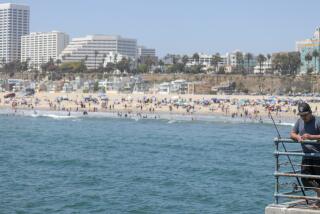A Cool 3 Degrees of Separation
What a difference 3 degrees makes. As in Fahrenheit. As in the weather. As in cool.
Southern California--all of California, for that matter--is in the midst of a cool wave. Itâs so cool that Southern Californians have taken to sounding like Midwestern farmers when it comes to the weather topic.
Yet the difference in Los Angelesâ average temperature for July was a scant 3.3 degrees--70.9 instead of the 74.2 norm.
But just that difference made it the coolest July in a decade. Itâs taken the swelter out of Pasadena. Itâs meant colder ocean water and fog at the beaches. Itâs put a crimp Rick Craigâs Monrovia air-conditioning business, as well as the beach traffic at Kenny Zoelleâs Dolphin Market in Seal Beach.
But it has also kept fire danger in check in the mountains and meant relief for those normally sweltering this time of year. The weather played a major role in the stateâs averting the crippling power outages that seemed unavoidable with the coming of summer. And while this coolness should end soon, Southern Californians are not alone with this odd weather. Only this week, the San Francisco Chronicle ran an editorial promising that there is, indeed, a sun out there.
This, as much of the rest of the country suffers through a major heat wave thatâs been a factor in at least 54 deaths.
So whatâs going on here?
The answer comes from Todd Morris of the National Weather Serviceâs Oxnard office. He said that basically, June and July traded places this year. Juneâs normal gloom arrived in July.
âJune is normally cooler and cloudier,â Morris said. âThis particular year weâve seen a complete flip-flop of that weather pattern.â
Morris said several factors are at play in this weather phenomenon. The first is a drop of water temperature along the Pacific coast. Though the water is only about 3 degrees cooler--that number again--Morris said the lower temperature, coupled with warm desert air made for a month of fog and clouds that kept the sun shrouded.
Another factor is a trough of low pressure, stretching from Canadaâs Vancouver to Southern California, that also is conducive to fog and cloud cover. âThey move inland and retreat during the day as the land heats up,â Morris said. That hasnât helped Craigâs air-conditioning business, which has been flat except for a short temperature spike in early July--the hottest it got in L.A. all month was 88. He says that people havenât been turning on their air conditioners, which means his services arenât required. âSince weâve gotten into this cooler climate, itâs just too comfortable from an AC guyâs point of view,â he said.
The same is true for Zoelle, whose market is a fixture in Seal Beach. He said his worst enemy is not fog at the beach, but clouds and coolness inland. âIt has to be hot here, but it also has to be hot inland to drive people to the beach,â he said. âThe weather is everything for me. The sun needs to be out at 6 in the morning so people will say, âLetâs go to the beach today.ââ
At the Rose Bowl Aquatic Center in Pasadena, director Judith Biggs said there had been a drop-off of swimming, particularly in the evening when families normally seek relief from the heat. âIn a very hot week, the evening rec swim is packed,â she said. âA lot of times, it is a way to deal with the heat of the day, especially if you donât have air-conditioning.â
In the Angeles National Forest, the cool weather has served to reduce the fire danger. But fire planner Don Garwood said the heart of the fire season wouldnât start for another month and that anything could happen if a stiff wind kicked up. âAll the indicators go out the window with wind,â he said.
Meanwhile, energy officials have been urging continued conservation, warning that the âguns of Augustâ are upon us.
Morris, of the National Weather Service, said the long-range computer models used to predict change indicate the coolness of July will be replaced by heat in August--beginning next week. He said chances are that temperatures will be higher than normal by the middle of the month, and even threw in the possibility of thunderstorms near the mountains.
That doesnât surprise Biggs, who has seen enough Los Angeles summers to know that a month of coolness eventually has to balance out.
âWeâre going to pay for it in the end,â she said.
More to Read
Sign up for Essential California
The most important California stories and recommendations in your inbox every morning.
You may occasionally receive promotional content from the Los Angeles Times.










